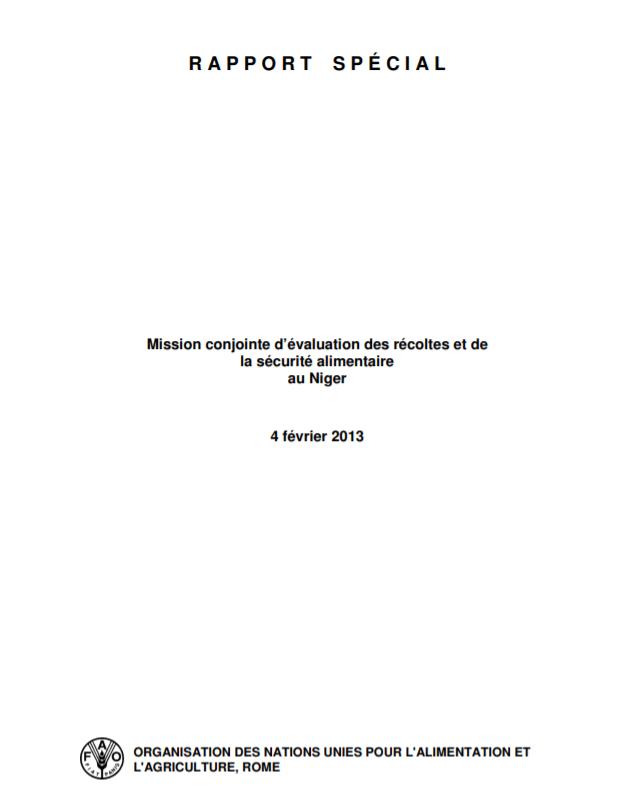
Rapport Spécial - Mission conjointe d’évaluation des récoltes et de la sécurité alimentaire au Niger
04/02/2013
La mission conjointe CILSS/FAO/FEWSNET/PAM a visité le pays du 22 octobre au 9 novembre 2012. Durant la première semaine, les experts et représentants de la FAO, du PAM, du CILSS-AGRHYMET et de FEWSNET en collaboration avec les responsables des ministères, ont adopté le programme de travail de la mission et ont tenu des séances de travail avec les services nationaux intervenant dans le suivi de la campagne agricole, la prévision des récoltes et la sécurité alimentaire. Une rencontre a été organisée avec le Groupe de travail pluridisciplinaire (GTP) à laquelle ont assisté les représentants de la Direction de la protection des végétaux (DPV), la Direction des cultures vivrières (DCV), la Météorologie nationale, le Système d’alerte précoce (SAP), le Dispositif national de prévention et de gestion des crises alimentaires (DNPGCA), les Systèmes d’information sur les marchés de bétail (SIM Bétail) et sur les marchés agricoles (SIMA) et la Direction des statistiques agricoles (DSA). La Mission a bénéficié de l’appui de toutes les directions centrales et régionales des Ministères de l’agriculture et de l’élevage ainsi que l’appui des autres services et ministères sollicités.
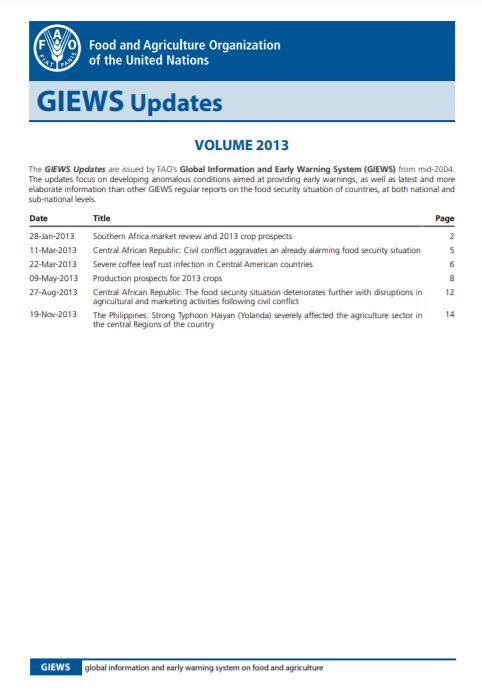
GIEWS Updates - Volume, 2013
28/01/2013
The GIEWS Updates are issued by FAO’s Global Information and Early Warning System (GIEWS) from mid-2004. The updates focus on developing anomalous conditions aimed at providing early warnings, as well as latest and more elaborate information than other GIEWS regular reports on the food security situation of countries, at both national and sub-national levels.
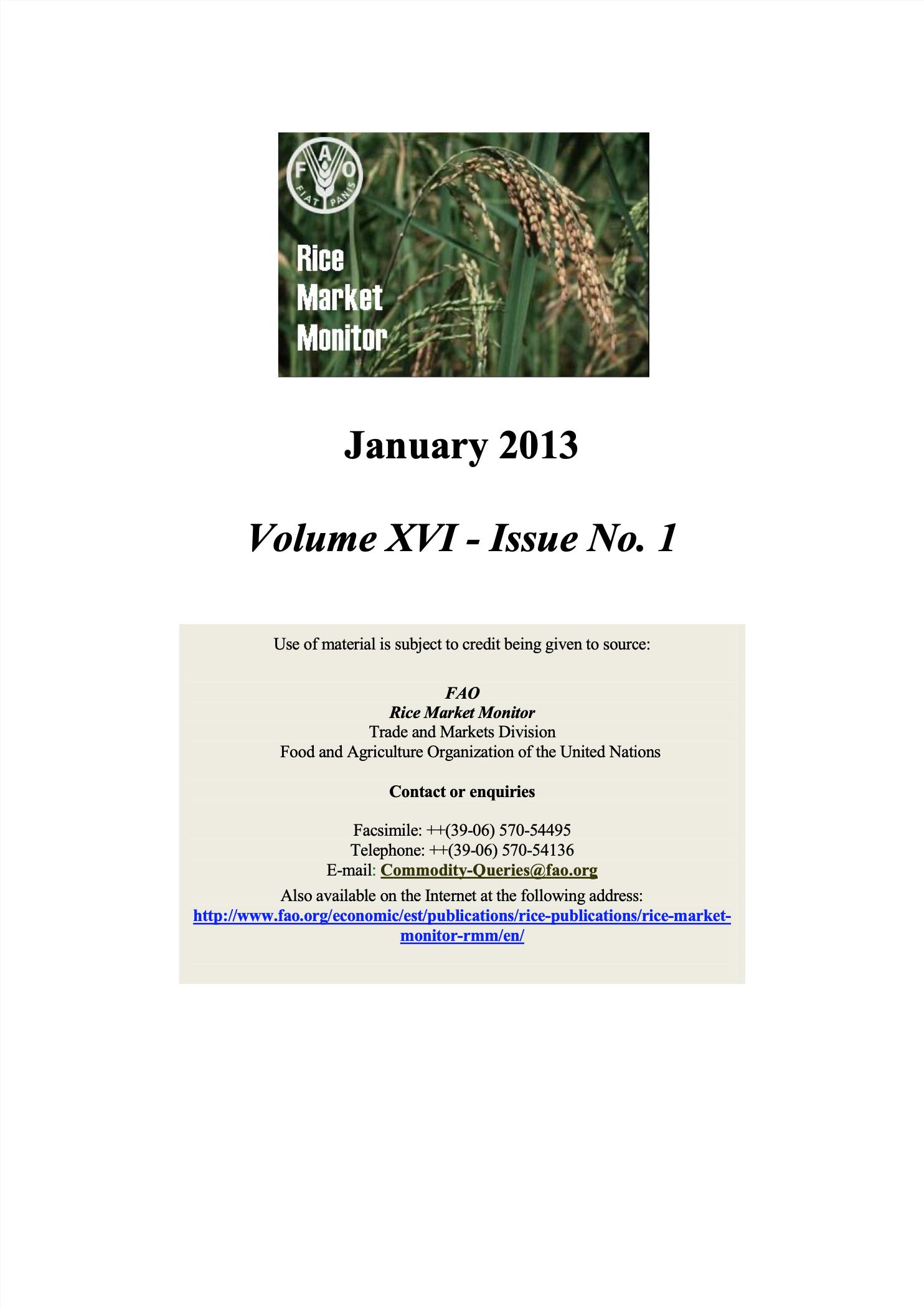
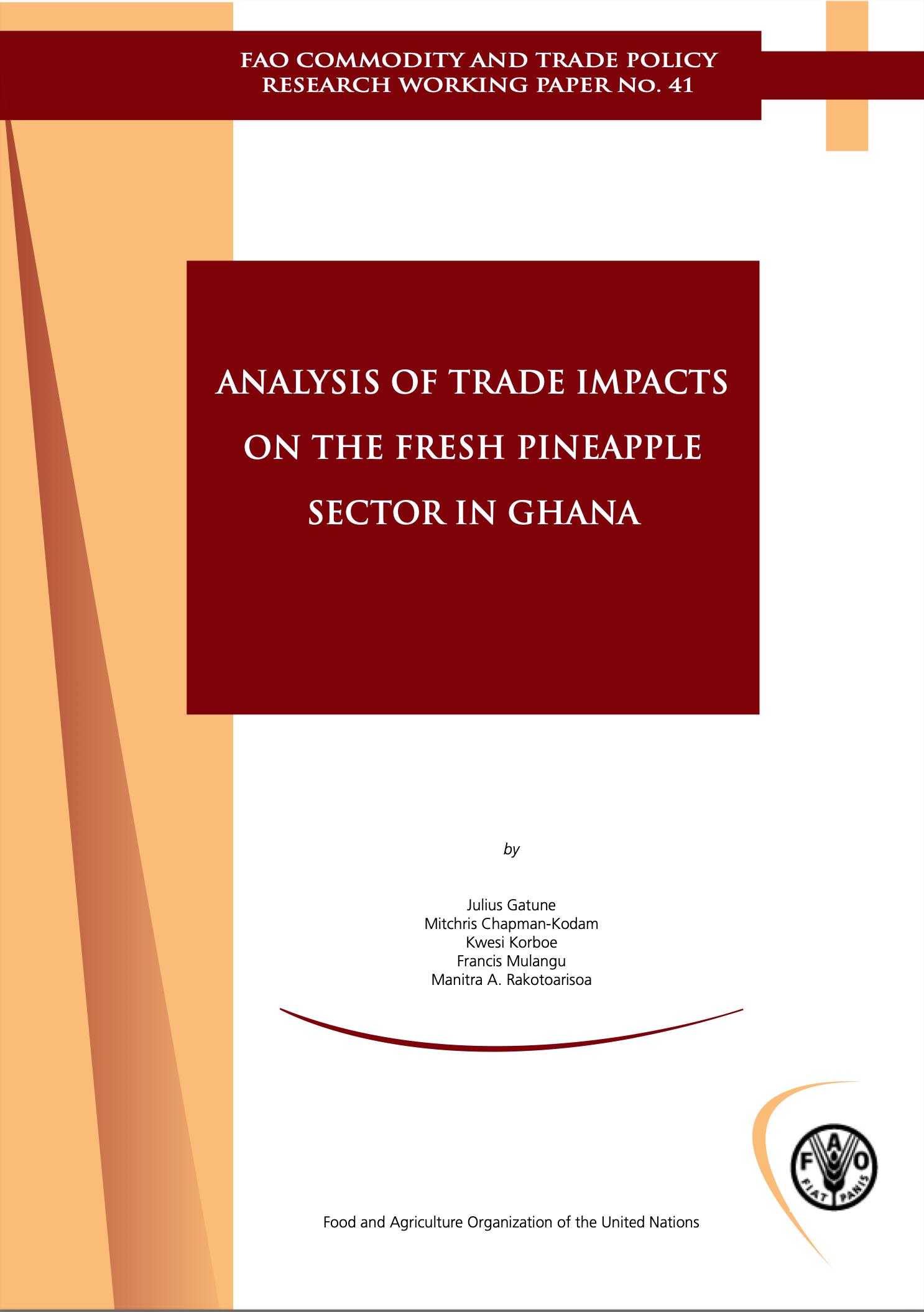
Analysis of trade impact on the fresh pineapple sector in Ghana
01/01/2013
This paper analyses the size and distribution of the impacts of pineapple export on trading firms and growers in Ghana. It examines the development of the pineapple export and policies in Ghana, and estimates the effects of the trade shock prompted by the varietal shift of pineapple export demand. The paper discusses main policy implications of the findings for the future of Ghana’s production and export of fresh pineapple.
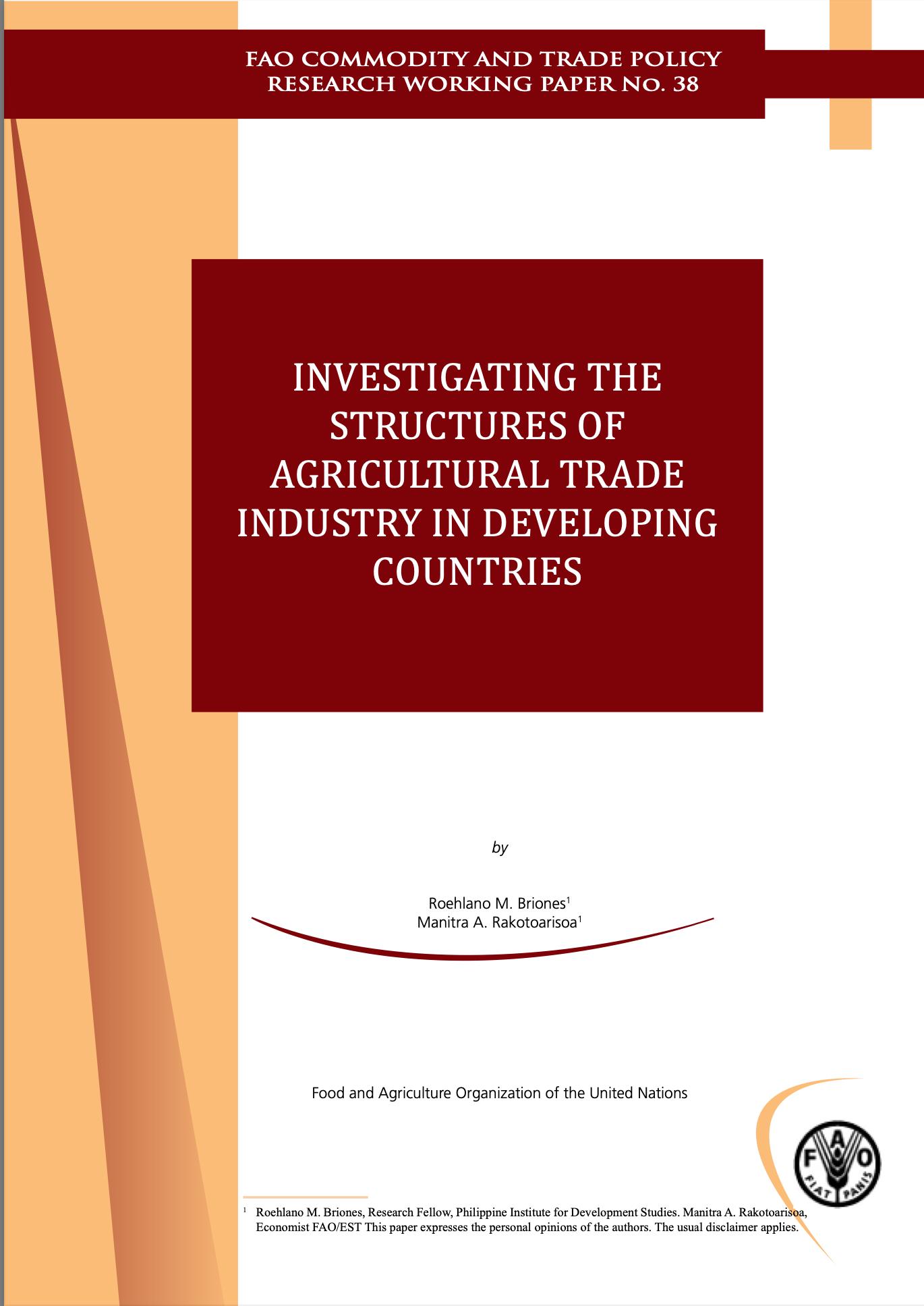
Structural changes in the sugar market and implications for sugarcane smallholders in developing countries
01/01/2013
World sugar has experienced a number of trade and policy changes. Their impact on the sugar sector and stakeholders in developing countries has yet to be fully understood. For developing countries such as Ethiopia and the United Republic of Tanzania, which have the potential to expand sugar production and exports, understanding the impact of current and prospective trends in the world sugar market on the income and wages of smallholders and workers can provide useful insights into the contribution of the sugar sub-sector to development goals. This paper employs econometrics and simulation techniques on household survey data to analyze the effect of a set of policy and market scenarios on employment and income of stakeholders (smallholders, workers) in the sugar sub-sectors of Ethiopia and the United Republic of Tanzania. The study reviews the current state of the world sugar market, discusses the likely impacts of various market and trade policy scenarios, and identifies the linkages between the macro level changes and earnings of small stakeholders. The key findings are that changes in international markets have limited effects on smallholders’ income, mainly because of the low supply response of smallholders in the face of relatively high elastic global supply. The increase in border price of sugar is beneficial to small farmers if the opportunity cost of land is low, or if domestic agricultural prices become more flexible.
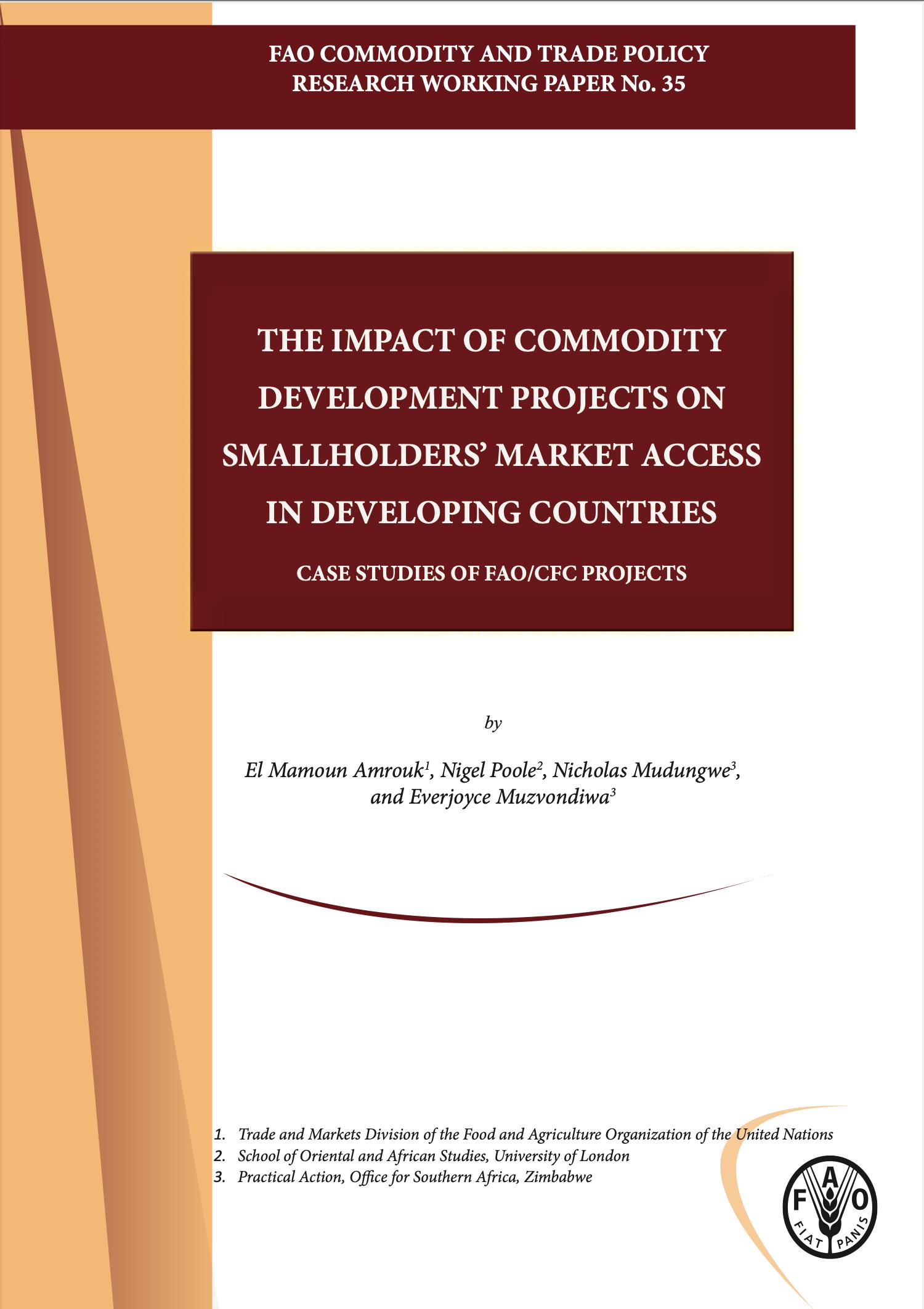
The impact of commodity development projects on smallholders’ market access in developing countries
01/01/2013
This report is part of an initiative by the Trade and Markets Division of the Food and Agriculture Organisation (FAO) to analyse patterns of smallholder market participation. It was prepared by El Mamoun Amrouk, in collaboration with Nigel Poole, Nicholas Mudungwe, and Everjoyce Muzvondiwa. Jamie Morrison provided guidance and input for the methodological framework, as well as comments on the initial drafts. Thanks to Grace Musarurwa for the input to the research and coordination of the field surveys. The collaboration and assistance of the Common Fund for Commodities (CFC), and in particular Guy Sneyers, is gratefully acknowledged. Special thanks for the support and assistance of the following FAO colleagues: Patrizia Mascianà, Peter Thoenes, Barbara Ferraioli, Paola Fortucci, Kaison Chang, Boubaker Ben-Belhassen, and David Hallam.
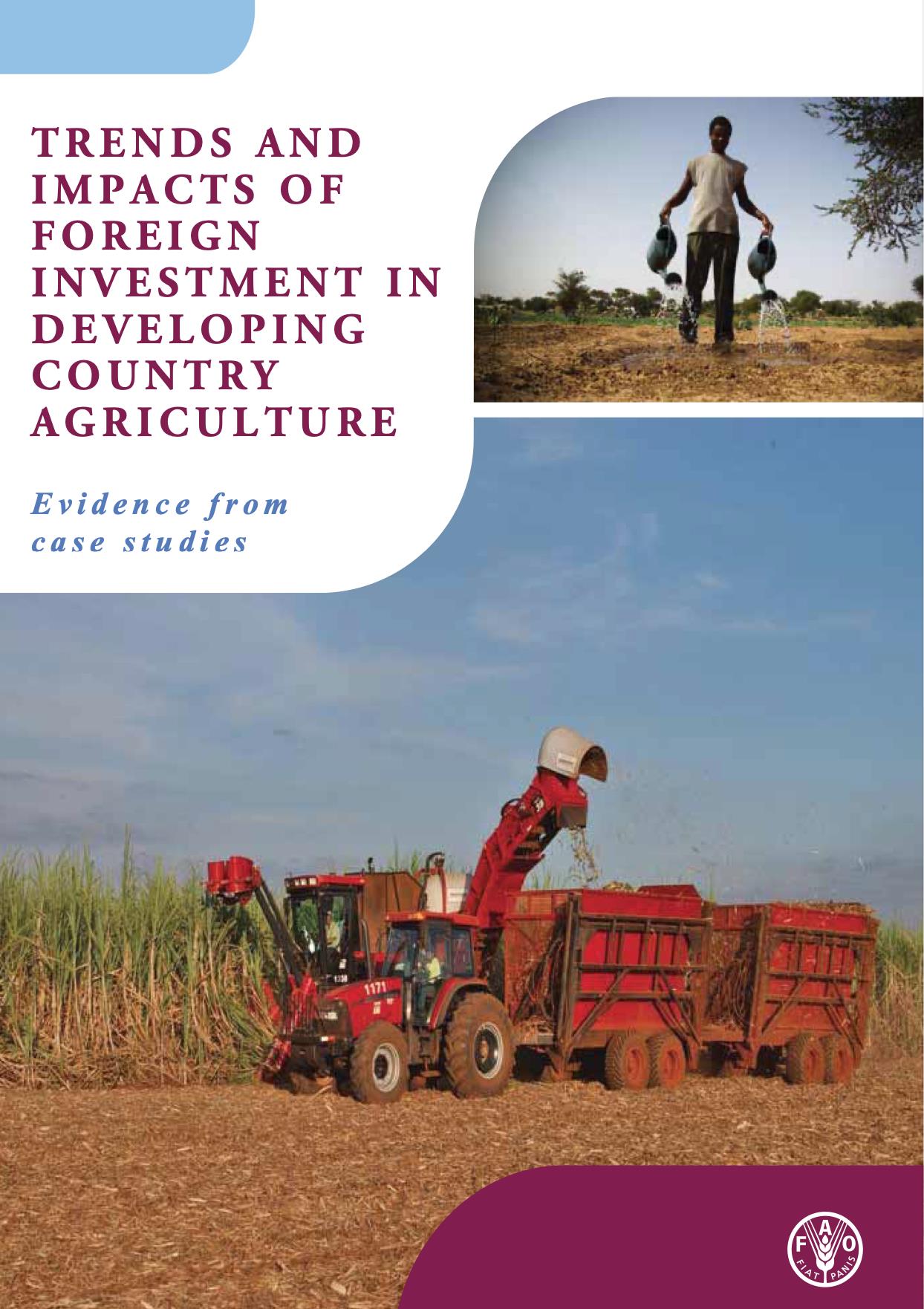
Trends and impacts of foreign investment in developing country agriculture
01/01/2013
In order to acquire an in - depth understanding of potential benefits, constraints and costs of foreign investment in agriculture and of the business models that are more conducive to development, FAO has undertaken research in developing countries. The research aims to provide better knowledge on the trends and impacts of foreign direct investment on host communities and countries, to gather evidence on inclusive business models, to identify good practices and to develop guidance for host gov ernments. This publication summarizes the results of this research, in particular through the presentation of the main findings of case studies in nine developing countries. It presents case studies on policies to attract foreign investment in agriculture and their impacts on national economic development in selected countries in Africa, Asia and Latin America.
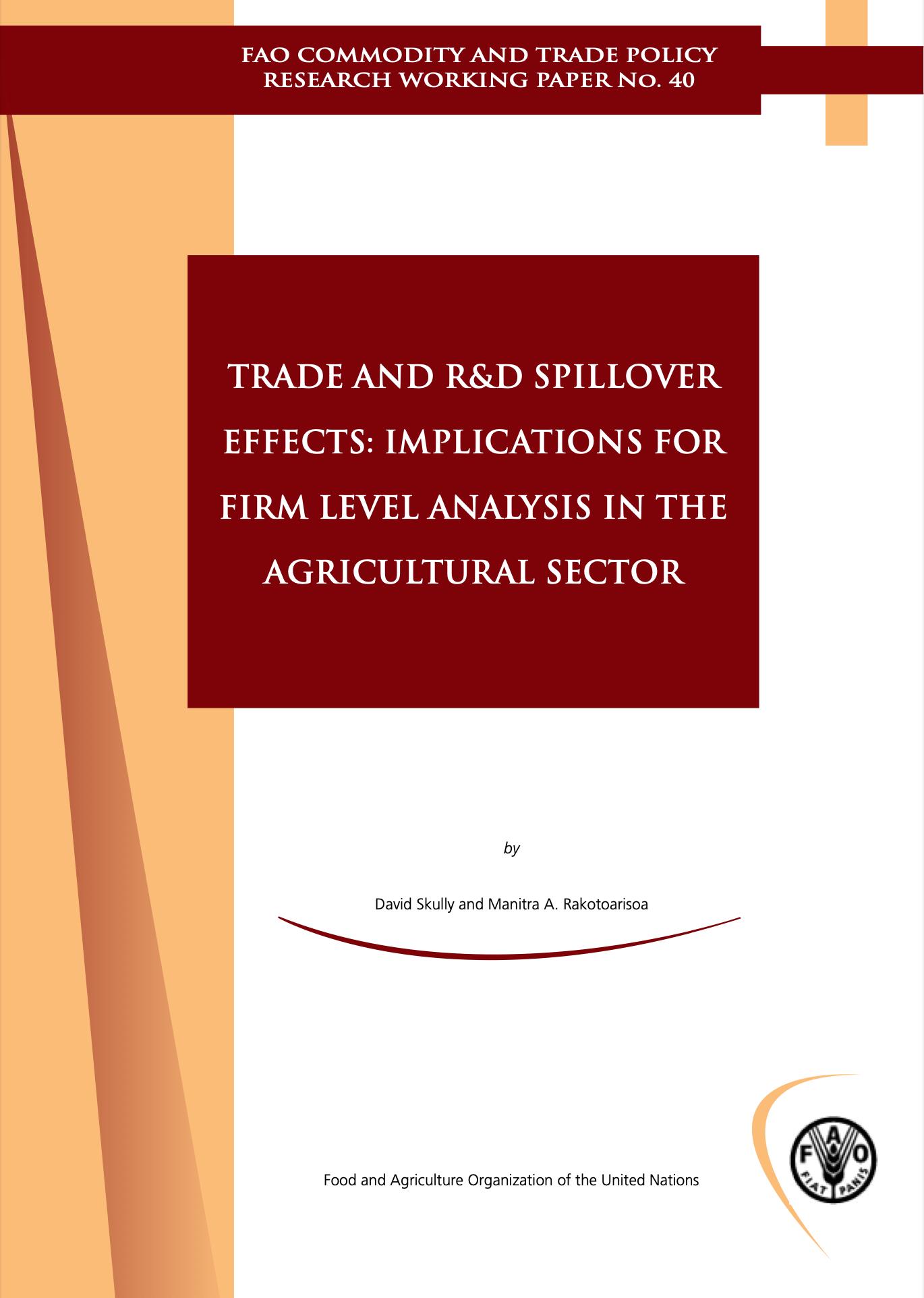
Trade and R&D Spillover Effects: Implications for Firm Level Analysis in the Agricultural Sector
01/01/2013
This paper provides a critical review of the economic literature on the relationship between international trade and research-and-development (R&D) spillovers with the aim of exploring ways to estimate the R&D spillover effects of agricultural trade at firm and industry levels.
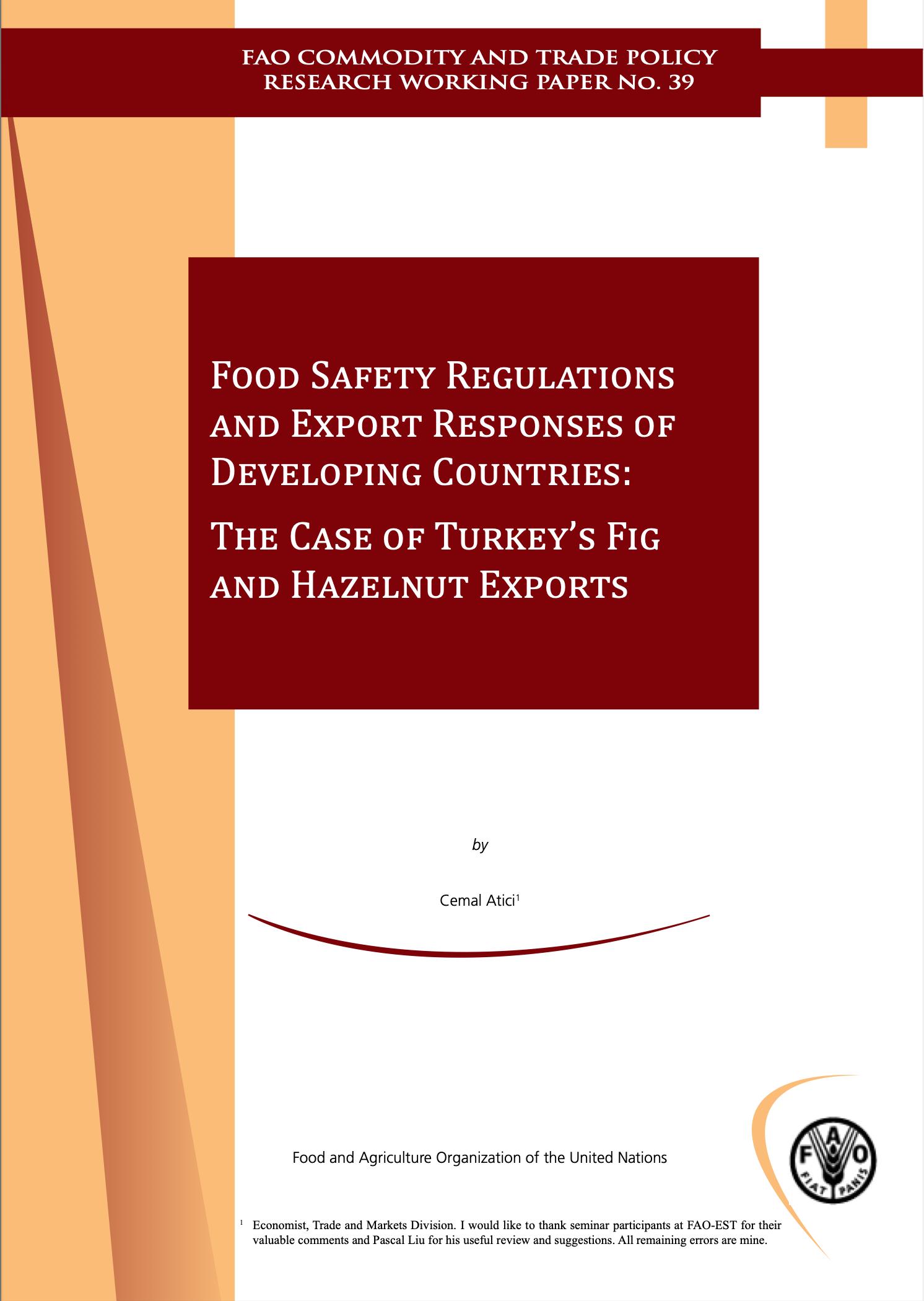
Food safety regulations and export responses of developing countries: The case of Turkey’s fig and hazelnut exports
01/01/2013
Food safety standards are gaining importance as trade regulations. These regulations affect exports in three main ways depending on the capacities of exporting countries: trade-impeding effects, neutral effects, and catalyst effects. Although previous studies confirm the trade impeding effect of regulations, recent studies show that strict regulations can stimulate developing countries through the scale effect as in the case of some African exporters. In addition, developing countries can benefit from extensive governmental guidance in terms of coping with standards. Harmonization of standards as a requirement of economic integration also leads to improvement in export performance. This study outlines the interaction between regulation and export responses by examining the change in export flow from Turkey to the EU partners after food safety regulations of the EU were put into effect, drawing policy implications in terms of food safety-export performance interaction. The empirical results show that the harmonization of EU food safety regulation in 2002 positively influenced hazelnuts exports, while the EU food safety regulation in 2007 reduced the volume of fig exports. The rise in export unit values indicates that Turkish primary food products responded to the EU food safety regulation with quality improvements accompanied by higher unit prices.
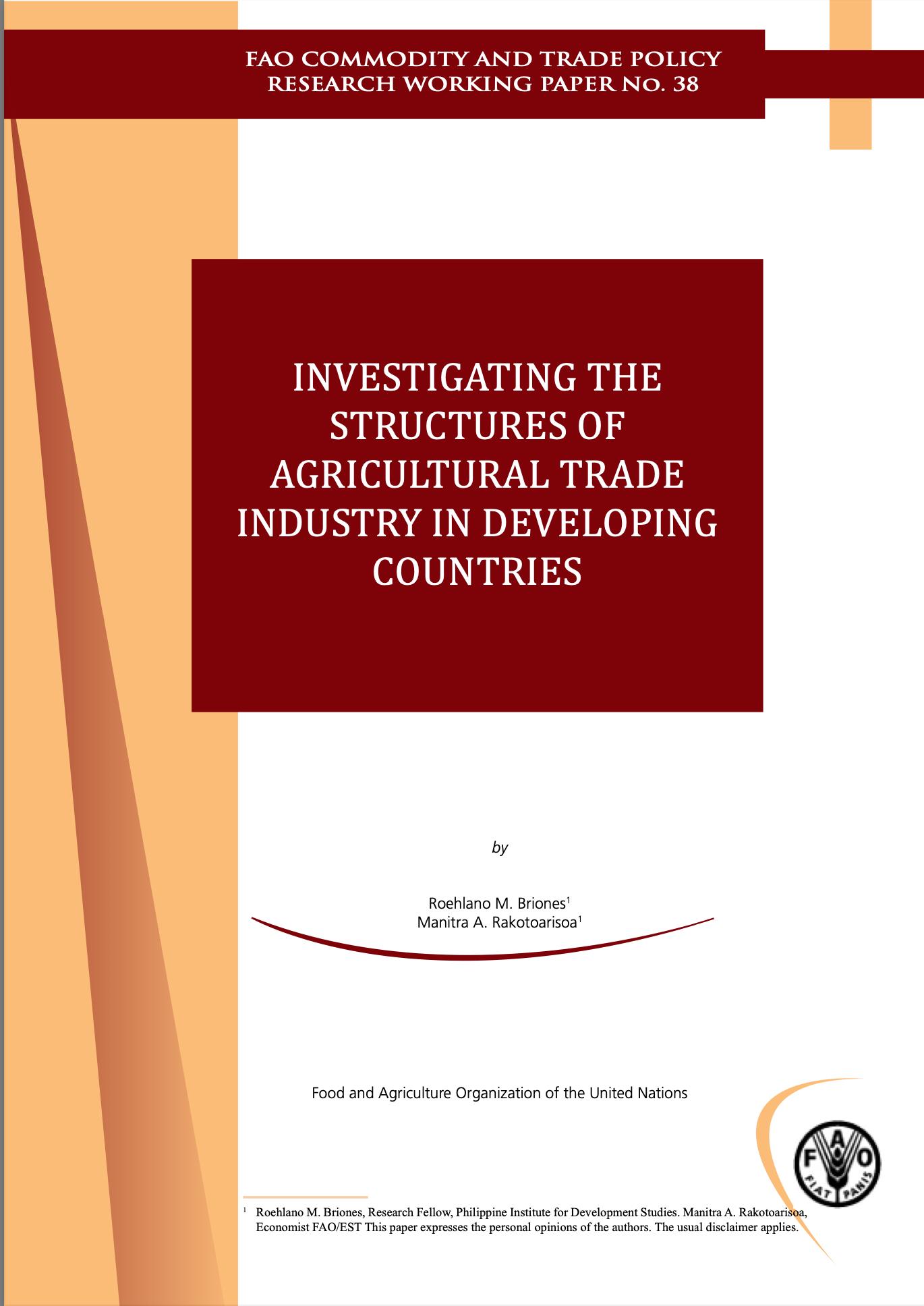
Investigating the Structures of Agricultural Trade Industry in Developing Countries
01/01/2013
This paper reviews the theories and evidence on the structure of agricultural trade industry in developing countries. Based on a literature survey, the paper seeks to determine the causes leading to the industry structure and how the structure affects the distribution of trade impacts among firms.
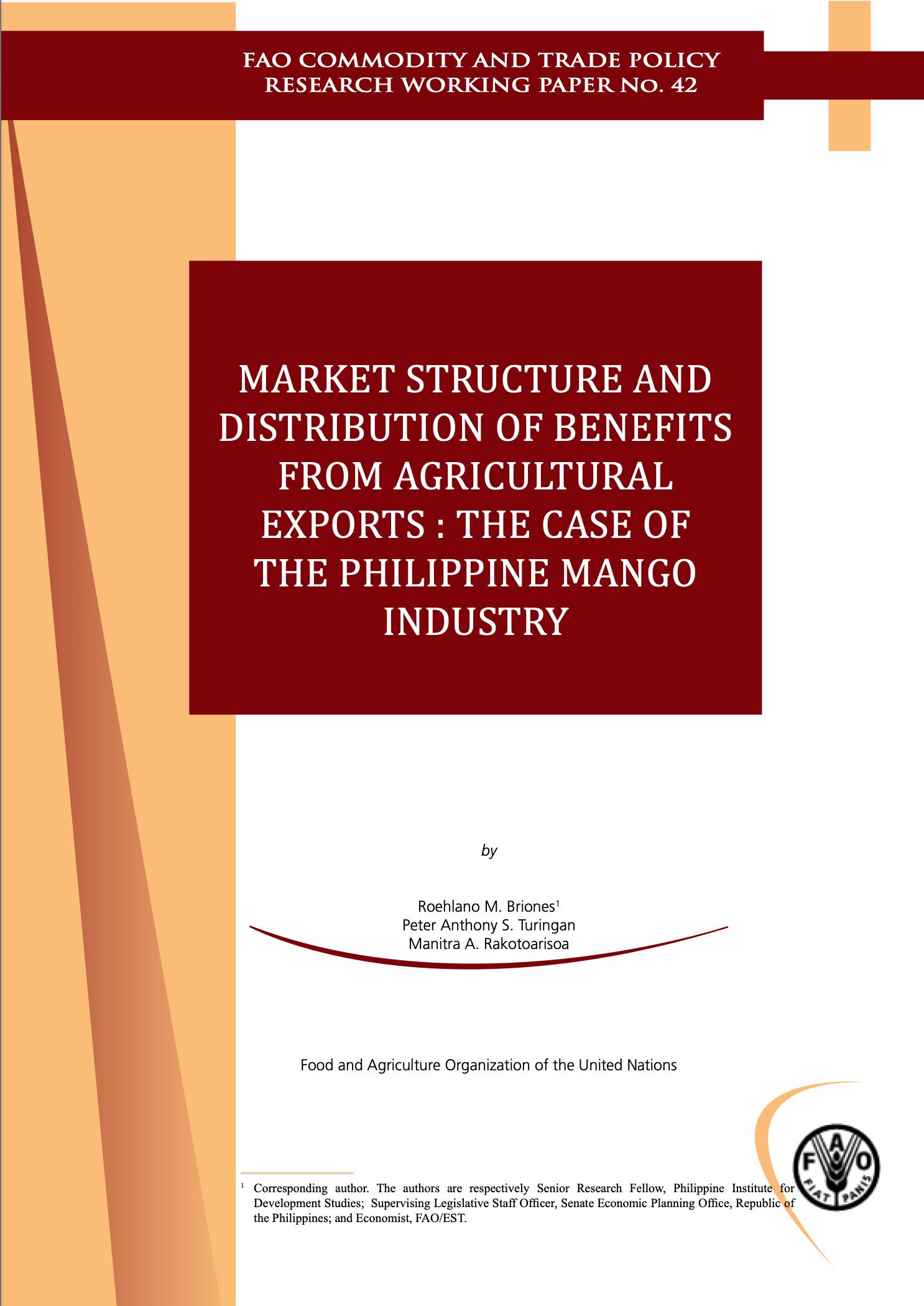
Market structure and distribution of benefits from agricultural exports : the case of the philippine mango industry
01/01/2013
To illuminate the role of agro-export industry in inclusive growth, this case study on Philippine mango focuses on the role of market structure in the distribution of export benefits. It is based on review of industry trends and related studies, open-ended interviews of key informants, and structured interviews of respondents situated along the value chain. The distribution of trade benefits is hypothesized to depend on both vertical and horizontal market structure. The former implies that a contracting relationship or vertical integration is a mechanism to elevate product quality to export grade. The latter implies that economies of scale are a factor in mango exporting, at the marketing and processing stages. It is noteworthy that there are no discernible economies of scale at the primary level, which accounts for the prevalence of smallholder growing at the production stage.
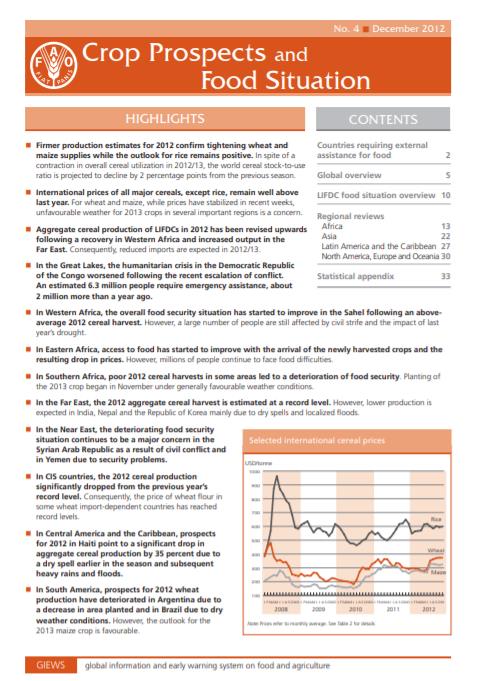
Crop Prospects and Food Situation #4, December 2012
06/12/2012
Firmer production estimates for 2012 confirm tightening wheat and maize supplies while the outlook for rice remains positive. In spite of a contraction in overall cereal utilization in 2012/13, the world cereal stock-to-use ratio is projected to decline by 2 percentage points from the previous season. International prices of all major cereals, except rice, remain well above last year. For wheat and maize, while prices have stabilized in recent weeks, unfavourable weather for 2013 crops in several important regions is a concern. Aggregate cereal production of LIFDCs in 2012 has been revised upwards following a recovery in Western Africa and increased output in the Far East. Consequently, reduced imports are expected in 2012/13.
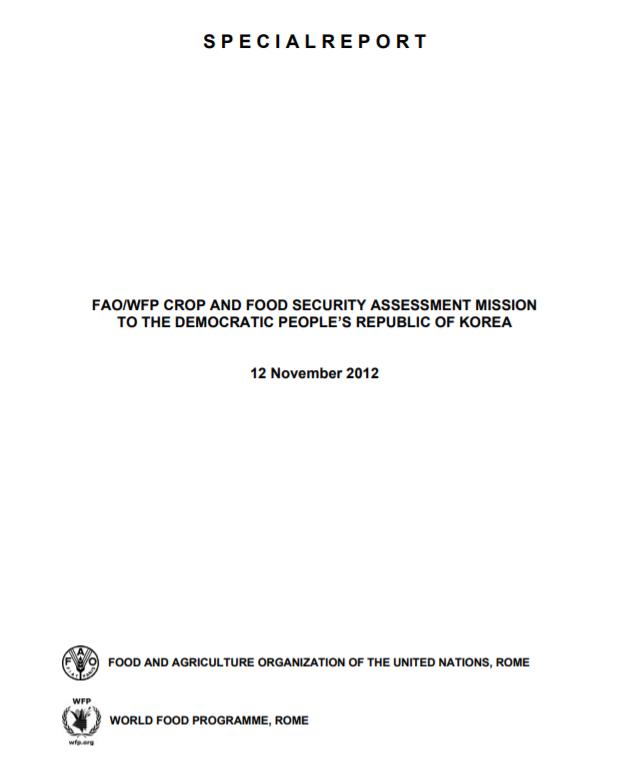
Special Report - FAO/WFP Crop and Food Security Assessment Mission to the Democratic People's Republic of Korea - 12 November 2012
12/11/2012
An FAO/WFP Crop and Food Security Assessment Mission (CFSAM) visited DPRK, at the request of the Government, from 24 September to 8 October 2012 to assess the 2012 main crop harvest, forecast the 2013 production of winter and spring crops, estimate cereal import requirements for the 2012/13 marketing year (November/October), assess the household food-security situation and estimate food assistance needs.
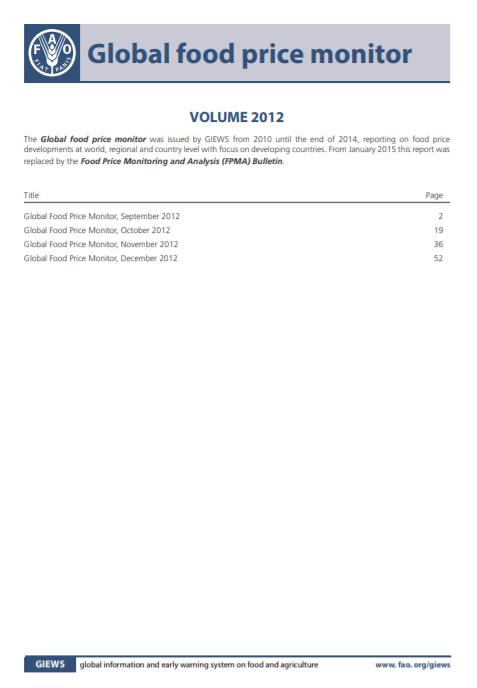
Global food price monitor - Volumke 2012
08/11/2012
The Global food price monitor was issued by GIEWS from 2010 until the end of 2014, reporting on food price developments at world, regional and country level with focus on developing countries. From January 2015 this report was replaced by the Food Price Monitoring and Analysis (FPMA) Bulletin.
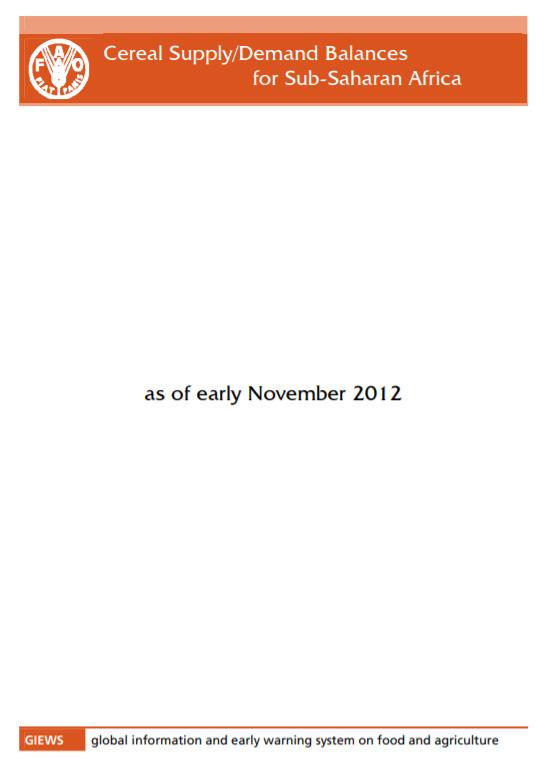
Cereal supply and demand balances for sub-Saharan African countries - No.4, November 2012
08/11/2012
The FAO/GIEWS Country Cereal Balance System (CCBS) is a database of annual supply and utilization balances for main cereals, covering all countries of the world. It has been maintained by FAO/GIEWS since 1980 and is updated on a continual basis. This statistical report, which is a subset of CCBS data, presents the current-year cereal supply and demand balances for all sub-Saharan African countries, highlighting cereal import and food aid requirements of each country. This report is complement ary to the FAO/GIEWS report Crop Prospects and Food Situation and is published four times a year, with the same schedule.
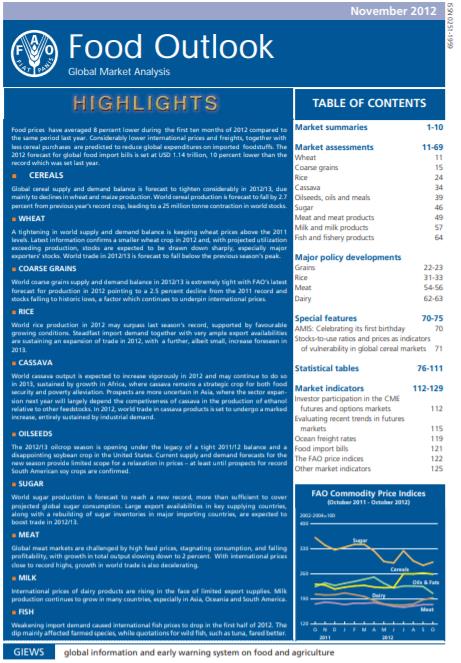
Food Outlook - November 2012
05/11/2012
Food prices have averaged 8 percent lower during the first ten months of 2012 compared to the same period last year. Considerably lower international prices and freights, together with less cereal purchases are predicted to reduce global expenditures on imported foodstuffs. The 2012 forecast for global food import bills is set at USD 1.14 trillion, 10 percent lower than the record which was set last year.
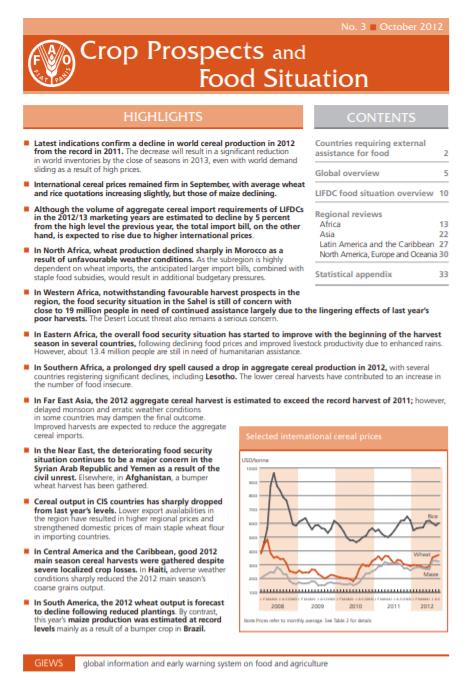
Crop Prospects and Food Situation #3, October 2012
11/10/2012
Latest indications confirm a decline in world cereal production in 2012 from the record in 2011. The decrease will result in a significant reduction in world inventories by the close of seasons in 2013, even with world demand sliding as a result of high prices. International cereal prices remained firm in September, with average wheat and rice quotations increasing slightly, but those of maize declining. Although the volume of aggregate cereal import requirements of LIFDCs in the 2012/13 marketing years are estimated to decline by 5 percent from the high level the previous year, the total import bill, on the other hand, is expected to rise due to higher international prices.
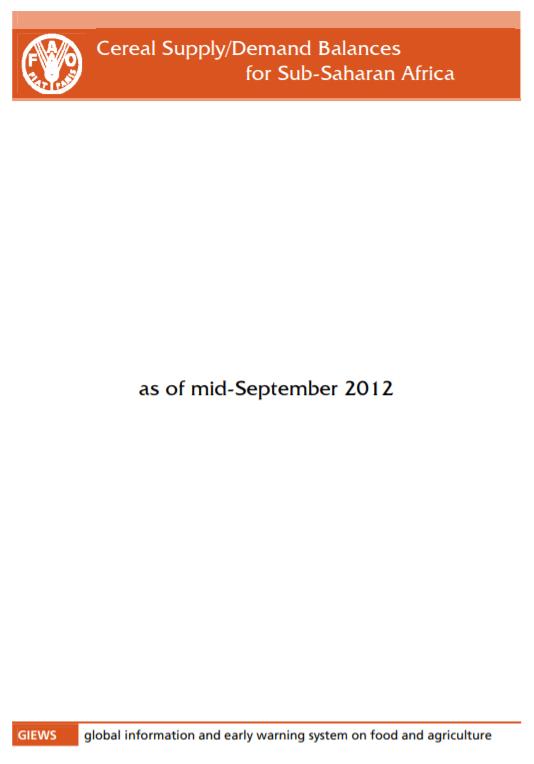
Cereal supply and demand balances for sub-Saharan African countries - No.3, September 2012
20/09/2012
The FAO/GIEWS Country Cereal Balance System (CCBS) is a database of annual supply and utilization balances for main cereals, covering all countries of the world. It has been maintained by FAO/GIEWS since 1980 and is updated on a continual basis. This statistical report, which is a subset of CCBS data, presents the current-year cereal supply and demand balances for all sub-Saharan African countries, highlighting cereal import and food aid requirements of each country. This report is complement ary to the FAO/GIEWS report Crop Prospects and Food Situation and is published four times a year, with the same schedule.
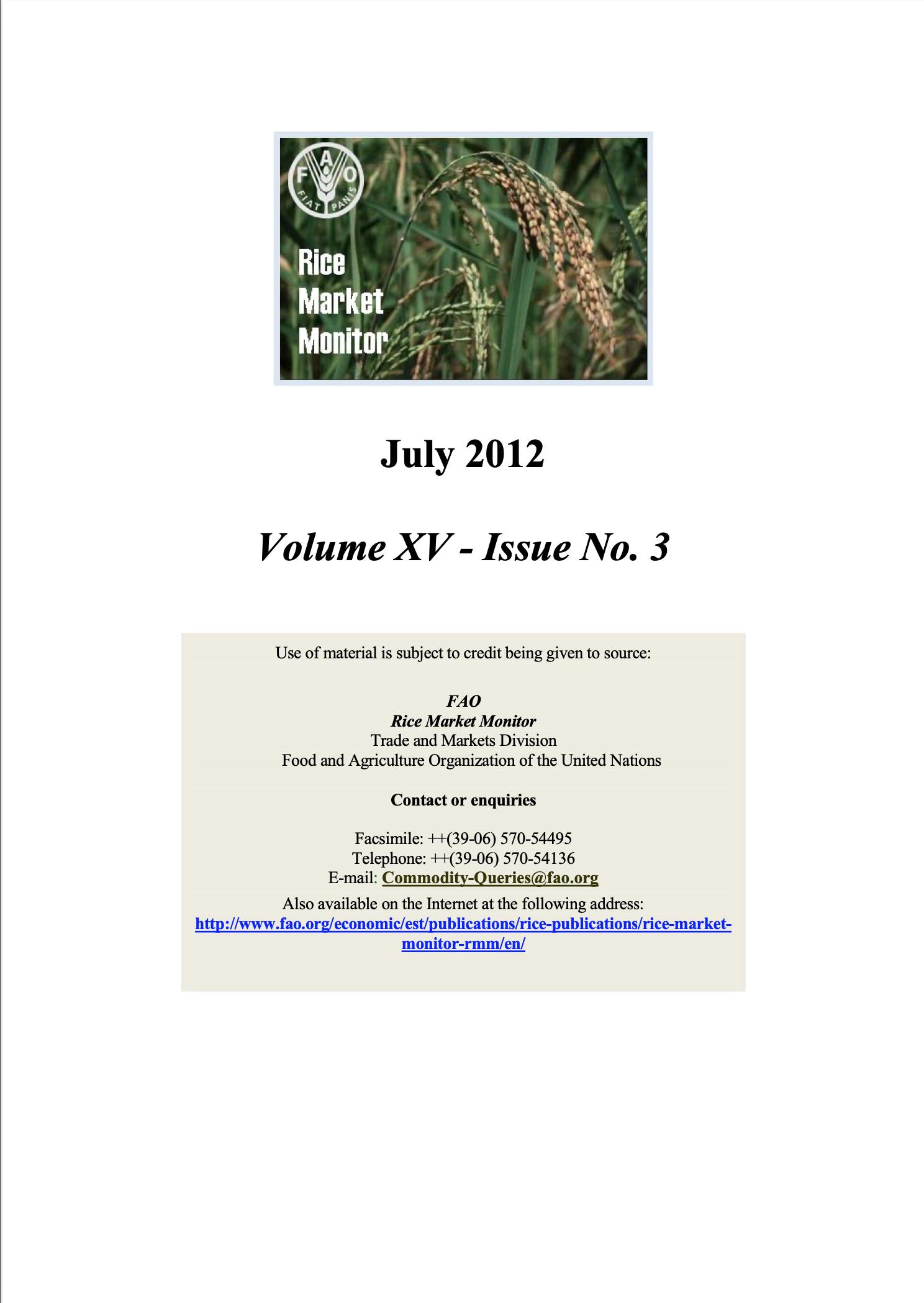
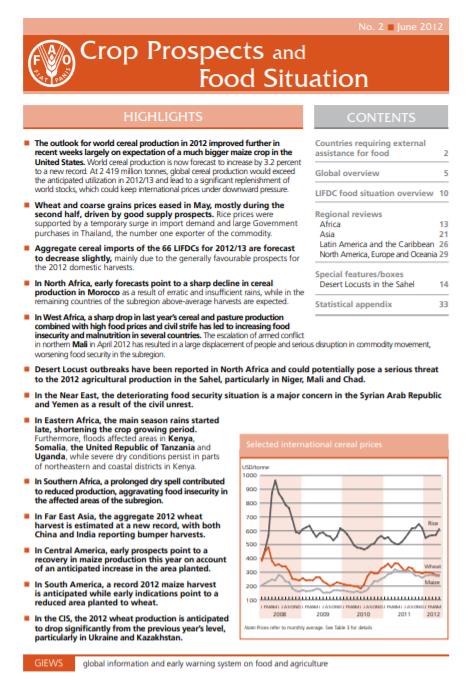
Crop Prospects and Food Situation #2, June 2012
07/06/2012
The outlook for world cereal production in 2012 improved further in recent weeks largely on expectation of a much bigger maize crop in the United States. World cereal production is now forecast to increase by 3.2 percent to a new record. At 2 419 million tonnes, global cereal production would exceed the anticipated utilization in 2012/13 and lead to a significant replenishment of world stocks, which could keep international prices under downward pressure. Wheat and coarse grains prices eased in May, mostly during the second half, driven by good supply prospects. Rice prices were supported by a temporary surge in import demand and large Government purchases in Thailand, the number one exporter of the commodity. Aggregate cereal imports of the 66 LIFDCs for 2012/13 are forecast to decrease slightly, mainly due to the generally favourable prospects for the 2012 domestic harvests.
